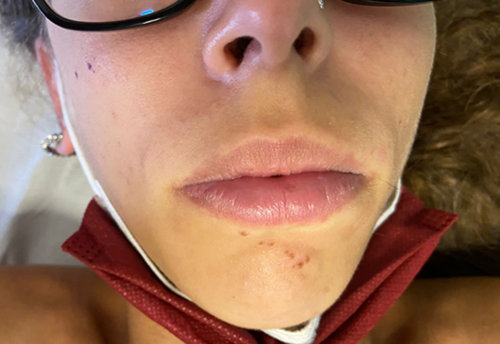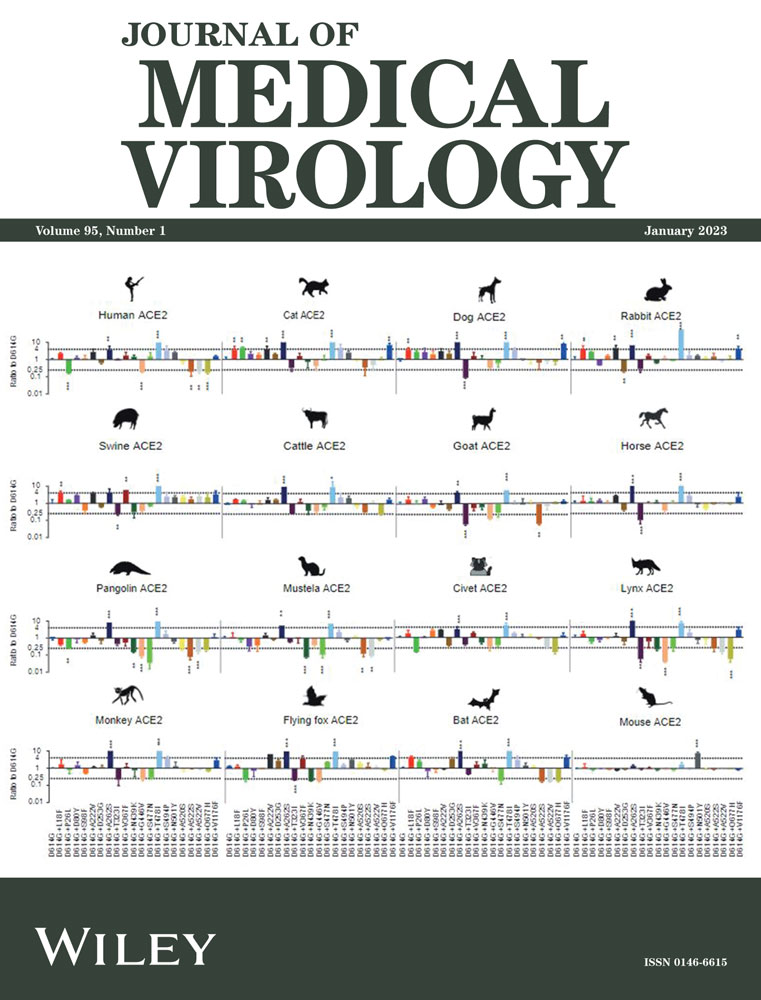Clinical, diagnostic features and complications of hand, foot, and mouth disease caused by coxsackievirus A6 in children and adults
We read with interest the article by Cui et al.1 on the epidemiological characteristics of hand, foot, and mouth disease (HFMD) clusters during 2016–2020 in Beijing, China, that prompted us to describe our experience.
In their study, Cui et al.1 identified Coxsackievirus (CV)-A6 as the major causative agent of HFMD and, in agreement with previous studies,2, 3 established that CV-A6-associated HFMD often occurs along with higher fever and more severe skin eruptions, compared to classic HFMD due to CV-A16. Likewise, in our series involving Italian adults, we found that CV-A6 represented the most frequent (40% of cases) type of enterovirus associated with more severe and atypical HFMD. The patients presented higher fever and other prodromal constitutional symptoms such as fatigue, sore throat, headache, muscle and joint pain, nausea, and abdominal discomfort. Furthermore, the patients showed atypical eruptions with vesicular oral lesions, variably associated with petechiae or strawberry tongue, and skin lesions involving hands more frequently than feet, with vesicles and bullae that spread frequently on the trunk, mimicking chickenpox.3, 4 Peculiarly, some patients had peri-oral erythematous papules, a finding unique to HFMD due to CV-A63, 4 (Figure 1). The lesions healed within 10–20 days (average 14 days), with mild scaling. In adults, as well as in children, CV-A6 can cause a high incidence of HFMD short-term complications, such as onychomadesis and Beau's line (transverse groove on nail plate).2 Onychomadesis is characterized by the separation of the nail plate from the matrix, along with persistent attachment to the nail bed and often, but not necessarily, with subsequent shedding of the nail. Onychomadesis and Beau's line are both caused by nail matrix arrest, possibly related to viral infection of proliferating stem cells. CV-A6 and other viruses like SARS-CoV-25 may damage the nail matrix and lead to the development of onychomadesis. Another rather uncommon short-term complication in our series is orchi-epididymitis, which usually follows a benign course, healing within 7–10 days. Furthermore, we found in three patients, monitored for 2 years, long-term sequelae such as chronic fatigue, myalgia, arthralgia, fibrosis of mitral and aortic valves with varying degree of regurgitation and cardiac arrhythmias. Among them, a 35-year-old woman, negative at the HFMD onset for antinuclear antibodies, antineutrophil cytoplasmic antibodies, and rheumatoid factor antibodies, developed in the following 2 years a symmetric polyarthritis, presenting the appearance of rheumatoid factor positivity and antibodies to cyclic citrullinated peptides.6 Notably, these three patients maintained low-level CV-A6 viremia over time.

In case of atypical and severe HFMD it is therefore crucial to carry out long-term follow-up to uncover the possible longstanding sequelae of HFMD due to CV-A16 in adults.7 Furthermore, it is important to recognize the atypical HFMD types, frequently erroneously diagnosed as atypical exanthems or drug reactions, and obtain detailed virological investigations from them.
Indeed, though the diagnosis of HFMD is predominantly clinical, it is important to ensure that a swab of vesicle fluid and/or blood samples are taken as soon as possible, to identify the exact enteroviral genotypes. Enterovirus RNA may be detectable by multiple RT-PCR assays targeting conserved genome regions of all Enterovirus types (5′UTR, 2C, 3Dpol) and next deep sequencing for Enterovirus genotyping.8
However, most laboratories do not have genetic tools to distinguish Enterovirus genotypes. Therefore, the development of a detection kit capable of recognizing more enteroviral genotypes is crucial for accurate virological diagnosis of HFMD.
On the other hand, physician should be familiar with the severe variants of HFMD caused by CV-A6 and include them in their differential diagnosis of acute febrile blistering diseases. It is crucial to consider the risk of onward transmission of the virus, also to adults, and with specific implications for pregnant women9 and immunocompromised patients. Physicians should identify the manifold alterations caused by EV and understand the diagnostic power of current virological investigation in differentiating clinical features and outcomes of classical HFMD and atypical HFMD due to CV-A6. In the latter case, patients should be followed up to rule out early complications such as nail damage and orchi-epididymitis, and possible long-term sequelae as persistent myalgia/arthralgia.
AUTHOR CONTRIBUTIONS
Francesco Broccolo and Francesco Drago wrote the article; Giulia Ciccarese and Gaetano Serviddio revised it critically.
ACKNOWLEDGMENT
We thank Dr. Camilla Caloi for the revision of the English language.
Open Research
DATA AVAILABILITY STATEMENT
The data that support the findings of this study are available from the corresponding author upon reasonable request.




